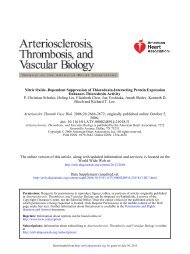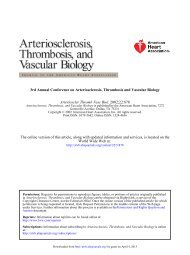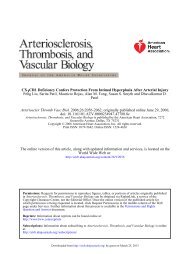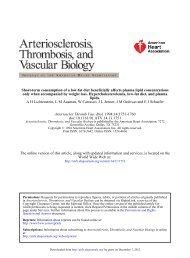Smooth Muscle Cells in Atherosclerosis Originate - Arteriosclerosis ...
Smooth Muscle Cells in Atherosclerosis Originate - Arteriosclerosis ...
Smooth Muscle Cells in Atherosclerosis Originate - Arteriosclerosis ...
You also want an ePaper? Increase the reach of your titles
YUMPU automatically turns print PDFs into web optimized ePapers that Google loves.
BM as performed <strong>in</strong> that experiment provides powerful<br />
protection aga<strong>in</strong>st the development of atherosclerosis. 11<br />
To address these concerns, we repeated the BM transplantation<br />
experiment <strong>in</strong> apoE / mice with a number of methodological<br />
modifications but could not replicate the results. To<br />
confirm and extend these f<strong>in</strong>d<strong>in</strong>gs, we then studied atherosclerosis<br />
<strong>in</strong>duced <strong>in</strong> surgically transferred arterial segments.<br />
Here, we show that atherosclerotic plaque SMCs are derived<br />
from the local vessel wall and not circulat<strong>in</strong>g smooth muscle<br />
progenitor cells <strong>in</strong> apoE / mice.<br />
Methods<br />
For a detailed Methods section, please see the onl<strong>in</strong>e data supplement,<br />
available onl<strong>in</strong>e at http://atvb.ahajournals.org.<br />
Transgenic Animals<br />
The Danish Animal Experiments Inspectorate approved all procedures.<br />
ApoE / mice (B6.129P2-Apoe tm1Unc ; Taconic M&B, Ry,<br />
Denmark), backcrossed more than 10 times to C57BL/6 mice, and<br />
eGFP C57BL/6 mice (C57BL/6-Tg[ACTB-EGFP]1Osb/J; Jackson<br />
Laboratories, Bar Harbor, Me), were <strong>in</strong>tercrossed to obta<strong>in</strong><br />
eGFP apoE / mice (hemizygous for the eGFP transgene).<br />
Bone Marrow Transplants<br />
ApoE / mice (n28) were lethally irradiated and rescued with<br />
sex-matched bone marrow from eGFP apoE / mice as previously<br />
described (Figure 1a). 12 Age-matched apoE / (n8) and<br />
eGFP apoE / mice (n8) were <strong>in</strong>cluded as controls. One mouse<br />
died shortly after BM transplantation. Four randomly-chosen BMtransplanted<br />
mice were killed after 4 weeks. The other mice were<br />
changed from chow to high fat diet (21% saturated fat, 1.5%<br />
cholesterol, Hope Farms, Woerden, Netherlands) to accelerate<br />
atherogenesis and then killed at 20 or 32 weeks of age.<br />
<strong>Atherosclerosis</strong> Induced <strong>in</strong> Transplanted<br />
Arterial Segments<br />
We performed orthotopic transplantations of common carotid artery<br />
(CCA) segments between eGFP apoE / and apoE / mice<br />
(eGFP apoE / CCA 3 apoE / transplanted mice, n12, and<br />
apoE / CCA 3 eGFP apoE / transplanted mice, n12, exclud<strong>in</strong>g<br />
perioperative deaths). Transplantations were isogenic apart from the<br />
eGFP transgene and immunogenicity of eGFP has been reported to<br />
be m<strong>in</strong>imal <strong>in</strong> the background C57BL/6 stra<strong>in</strong>. 13<br />
Bentzon et al Orig<strong>in</strong> of SMCs <strong>in</strong> <strong>Atherosclerosis</strong> <strong>in</strong> ApoE / Mice 2697<br />
Figure 1. Overview of experimental design and results. a, Analysis of sex-mismatched eGFP apoE / BM 3 apoE / transplanted mice<br />
us<strong>in</strong>g eGFP or Y chromosome as tracers. *Per total number of SMA profiles analyzed. † Per total number of nucleated SMA profiles<br />
analyzed. BMT <strong>in</strong>dicates bone marrow transplantation; HF, high-fat diet; AR, aortic root; AA, aortic arch; BT, brachiocephalic trunk;<br />
AbA, Abdom<strong>in</strong>al aorta; ThA, descend<strong>in</strong>g thoracic aorta. b, Analysis of atherosclerotic plaques <strong>in</strong>duced <strong>in</strong> transplanted CCA segments.<br />
CCAT <strong>in</strong>dicates common carotid artery segment transplantation. See text for description of additional control experiments.<br />
Downloaded from<br />
http://atvb.ahajournals.org/ by guest on June 4, 2013<br />
All grafted vessels were patent after 6 weeks. Then, localized<br />
atherosclerosis was <strong>in</strong>duced by placement of a constrictive perivascular<br />
collar around the distal part of the graft us<strong>in</strong>g a technique<br />
slightly modified from von der Thüsen et al (n10 from each group)<br />
(Figure 1b). 14 Four mice (eGFP apoE / CCA 3 apoE / transplanted<br />
mice, n2, and apoE / CCA 3 eGFP apoE / transplanted<br />
mice, n2) were treated identically with the exception that no collars<br />
were <strong>in</strong>serted.<br />
Immunohistochemistry<br />
SMCs were identified by sta<strong>in</strong><strong>in</strong>g for smooth muscle -act<strong>in</strong><br />
(SMA). This abundant prote<strong>in</strong> is considered the most sensitive,<br />
though not specific, SMC marker. SMA is expressed early <strong>in</strong><br />
embryonic development 15 and lost late <strong>in</strong> phenotypic modulation, 3<br />
and it is the marker on which previous conclusions on BM orig<strong>in</strong> of<br />
plaque SMCs have been based. 7,16 Specificity of SMA sta<strong>in</strong><strong>in</strong>gs<br />
was confirmed by observ<strong>in</strong>g the expected subplasmalemmal distribution<br />
of SMA <strong>in</strong> plaque SMCs and by negative isotype control<br />
sta<strong>in</strong><strong>in</strong>gs. The Mac2 epitope was used as a marker for<br />
plaque macrophages.<br />
Fluorescence In Situ Hybridization<br />
The Y chromosome was visualized <strong>in</strong> a subset of SMA sta<strong>in</strong>ed<br />
aortic root sections. First, z-axis image stacks of SMA cellconta<strong>in</strong><strong>in</strong>g<br />
areas were acquired and stored. Then, cover slips were<br />
removed and the immunosta<strong>in</strong>ed sections were pretreated <strong>in</strong><br />
10 mmol/L sodium citrate, pH 6.0 (2 hours, 80°C) and 0.025%<br />
peps<strong>in</strong> solution (10 m<strong>in</strong>utes, 37°C; Sigma), which totally ext<strong>in</strong>guished<br />
eGFP fluorescence and deteriorated the SMA sta<strong>in</strong><strong>in</strong>g<br />
signal. Y chromosomes were then detected by a fluoresce<strong>in</strong> isothiocyanate<br />
(FITC)-conjugated pa<strong>in</strong>t probe us<strong>in</strong>g the protocol recommended<br />
by the manufacturer (Cambio), and the phenotype of cells<br />
with Y nuclei was identified <strong>in</strong> the stored images. This sequential<br />
technique allows for a robust analysis, because the cell phenotype is<br />
analyzed before the harsh pretreatment necessary for fluorescence <strong>in</strong><br />
situ hybridization (FISH) distorts morphology.<br />
Microscopic Analysis<br />
Sections were exam<strong>in</strong>ed <strong>in</strong> an Olympus Cell-R epifluorescence<br />
microscope system equipped with differential <strong>in</strong>terference contrast<br />
(DIC) optics and motorized focus. Deconvolution analysis on widefield<br />
z-axis image stacks (0.3 m optical thickness) was performed<br />
<strong>in</strong> a subset of sections (aortic root sections for sequential FISH<br />
analysis and CCA plaques) by us<strong>in</strong>g a bl<strong>in</strong>d 3D deconvolution<br />
algorithm (Autoquant Deblur 9.3; Autoquant Imag<strong>in</strong>g). This tech-














